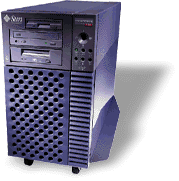Behind AnandTech - The Search for the Perfect Servers
by Anand Lal Shimpi on August 23, 2000 12:00 PM EST- Posted in
- IT Computing
Believe it or not, but AnandTech, once known as "Anand's Hardware Tech Page" had its roots on a free web hosting company that you may have heard of, Geocities. Back in April 1997, when the site was hosted at Geocities, the traffic was minimal and so were the annoyances of running a Geocities based site. There were no pop-up windows, no forced ads, just 2MB of free webspace and a suggestion to put a Geocities logo on your site.
Back then, you could count the number of hardware enthusiast sites on one hand, in fact, it would only take a couple of fingers. The big companies didn't really take the web seriously back then, although it wasn't very long ago, in Internet-time, it was an eternity. It was during this relatively calm period that AnandTech started to gain some ground and began to develop into what it is today.
The process was a very long one, spanning the course of almost 3.5 years and counting. And during that time, as long time AnandTech readers will vividly remember, we've been constantly hopping from one hosting provider to the next and more recently, we've been caught upgrading our server capacity more than a few times.
The reasons are simple, the more popular AnandTech gets, the more traffic comes our way. And the more traffic we get, the more powerful and plentiful our server solutions have to be in order to make sure that when you click on that link, today's articles, web news, forums and even our site comments pop up as soon as your connection can download them.
 Between
Geocities and the time we actually got our first physical server, AnandTech
was hosted on shared servers, meaning that there were multiple websites hosted
on a single box. This was perfectly suitable for us at the time since, although
our traffic was increasing, it wasn't great enough to warrant a move to a dedicated
server.
Between
Geocities and the time we actually got our first physical server, AnandTech
was hosted on shared servers, meaning that there were multiple websites hosted
on a single box. This was perfectly suitable for us at the time since, although
our traffic was increasing, it wasn't great enough to warrant a move to a dedicated
server.
The first dedicated server AnandTech ever moved onto was in the middle of 1998, the server itself was a Sun Microsystems' Ultra10S (left). Our pleasant experience with Sun would lead us to make the next server upgrade one that bore the same bright name.
 The
next upgrade actually marked a fairly big step in AnandTech history, it was
our first attempt at a database driven site. Running Oracle as the database
back-end, and Allaire's ColdFusion as our web front-end, our next server was
a Sun Microsystems Enterprise 250 (right). For those of you that remember the
first time we went live with this setup in December of 1998, it was accompanied
by our review of the AMD K6-III processor, months before AMD's official announcement.
That review not only managed to garner quite a bit of attention, but more importantly,
it managed to take down our brand new server.
The
next upgrade actually marked a fairly big step in AnandTech history, it was
our first attempt at a database driven site. Running Oracle as the database
back-end, and Allaire's ColdFusion as our web front-end, our next server was
a Sun Microsystems Enterprise 250 (right). For those of you that remember the
first time we went live with this setup in December of 1998, it was accompanied
by our review of the AMD K6-III processor, months before AMD's official announcement.
That review not only managed to garner quite a bit of attention, but more importantly,
it managed to take down our brand new server.
Our experience with Oracle, ColdFusion & Solaris combined left us with a very bad taste in our mouth. It turns out that the ColdFusion port for Solaris wasn't as mature as the NT port, in fact, CF for Solaris wasn't even a native port to Solaris, which caused quite a bit of trouble, including countless nights spent baby-sitting the server.
While our discovery process was continuing, our developers were combating the excessive load caused by people hitting the K6-III review by rewriting some of the Solaris threading libraries. It turns out that we picked the perfect combination of Operating System and application software, since none of it was working properly together.
We managed to get the site running in a fairly stable fashion on the Enterprise 250 server, that we quickly upgraded to house a second CPU as well as another 512MB of RAM provided by Memman.com. But within a couple of months it quickly became evident that we needed to upgrade to a better solution.
When it comes to serving dynamic content, which is what we do at AnandTech, it is best to have your database (where all of the content is stored) and your web server (what outputs the content to the user) on separate boxes. It doesn't take a rocket scientist to figure out why this is a better solution, but at the same time it took long enough for us to make the move towards a 1 DB + 1 Web server solution.
Learning from our mistakes, we didn't look towards Sun for our next server upgrade, instead we wanted to put ColdFusion on a platform it was known to run well on, Windows NT. Since the upgraded Enterprise 250 box wouldn't have a problem running solely as a database server (Solaris & Oracle got along quite well without CF in the picture), we looked towards putting together an ultra-fast web server.










0 Comments
View All Comments